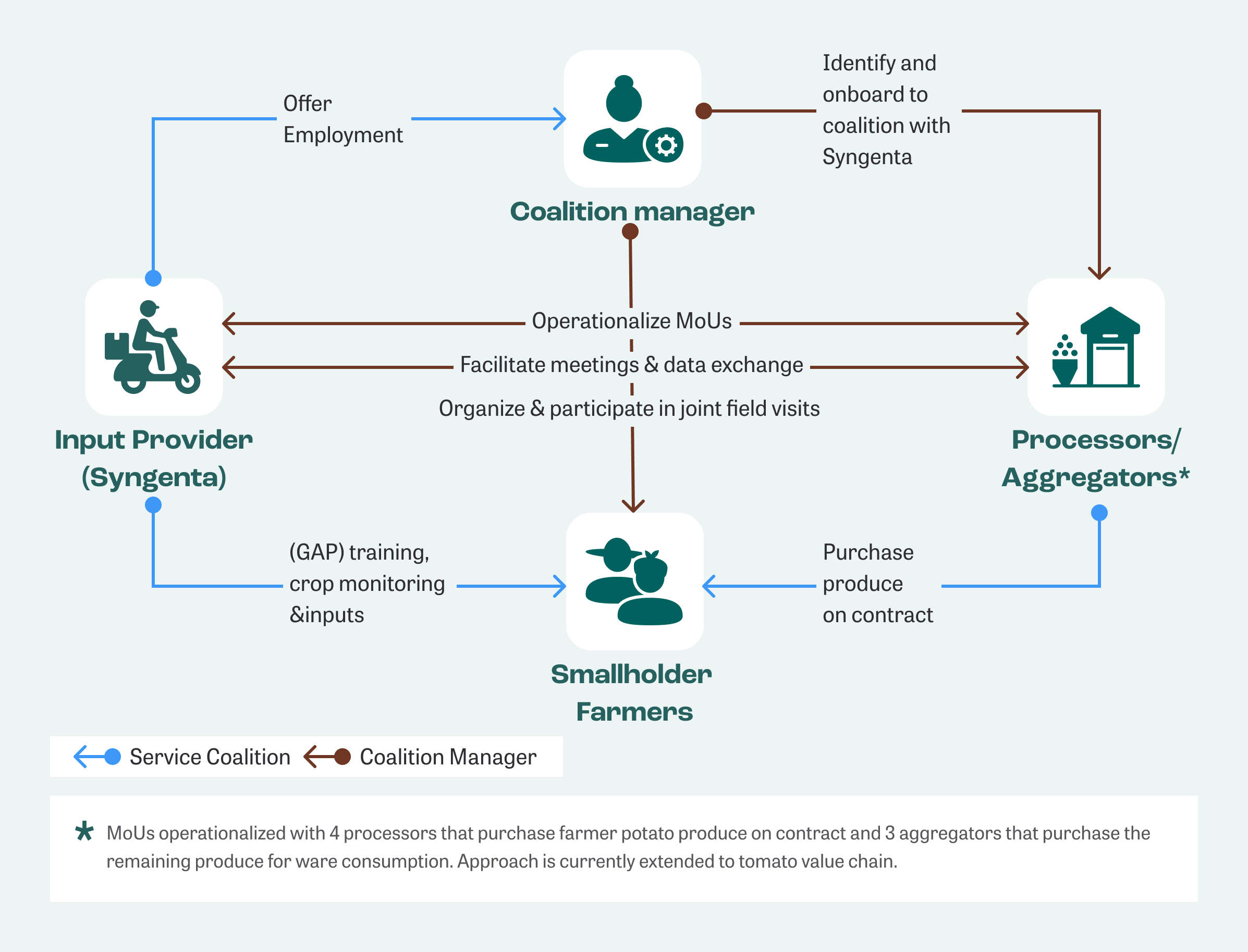Achieving a Sustainable, Well-Functioning Service Coalition Through a Service Coalition Manager
What is the Innovation?
A Service Coalition Manager (SCM) is a strategic function created to coordinate and manage the relationships and exchange of services between value chain actors in a service coalition (e.g. input providers, off-takers, financial service providers). The mandate of the SCM is to align coalition members on a common strategy, coordinate division of roles and responsibilities, and facilitate data sharing to create synergy in joint service delivery to smallholders and manage a sustainable service coalition.
Key Challenges Addressed
By sharing costs, risks, and revenue opportunities, service coalitions have the potential to benefit all parties, including smallholder farmers (see innovation case study on service coalitions). However, setting up a sustainable service coalition is often complex and requires a high degree of coordination. Syngenta was working within the challenges of an unstructured coalition, facing limited visibility on roles and responsibilities, and inadequate information exchange between partners. As a result, Memoranda of Understanding (MoUs) between Syngenta and off-takers were created but either never translated into concrete action plans or executed too slowly due to lack of direct communication between farmers and off-takers. The sustainability of the coalition was too dependent on Syngenta. Off-take arrangements failed and farmers’ access to market did not improve as envisioned. Eventually, the coalition between Syngenta and off-takers dissolved. Integrating the learnings from this experience, Syngenta appointed a project manager to take on the SCM mandate, including onboard new off-takers, devising a common strategy, clarifying and assigning roles and responsibilities, facilitating data sharing, and managing relationships over time. This role has become essential to the success and sustainability of the now well-functioning service coalition.
How it Works

Tips for Replication
Context
- No restrictions on crop/country
- Suitable for service coalitions in which farmers’ service needs are broad or the coalition involves many partners
Best Practices
-
Document the roles and responsibilities of different coalition members
- Set up a reporting structure between the SCM and all coalition partners
- Hire an SCM that is mobile (can visit partners and farmers), knows the sector, and has excellent communication skills
Enabling Conditions
- Geographical concentration of interconnected companies
- Complementary services offered by coalition partners
Business Case
Expected Outcomes for Syngenta and off-takers
Operationalized MoUs with 5 new off-takers
As of the date of publication of this case, the SCM onboarded 4 new processors and 3 aggregators to the coalition, resulting in signed contracts between farmers and processors. This facilitates farmer access to finance (reduced time for loan approval, increased number of disbursed loans). Syngenta has recorded increased sales of inputs since expanding access to structured markets and finance for farmers.
Aligned & efficient communication
Joint farmer visits by the SCM and off-takers, reduce sourcing costs for the off-takers, who would otherwise have had to identify and engage with farmers independently. Syngenta benefits from integrating market access because farmers are more likely to increase yields and subsequently volumes to meet their contractual off-take demands, potentially requiring more inputs from Syngenta.
Tailored farmer training
Data exchange on product requirements (seed varieties, other input usage, and quality specifications) between Syngenta and off-takers allows Syngenta to tailor farmer trainings. This has the potential to increase yield and thereby sourcing volume for off-takers. Clarity on situationally appropriate inputs and increased yield can lead to repeat customers for Syngenta.
Leadership buy in
Different partners are taking on more responsibility for different aspects of the coalition, setting it up for long-term sustainability by making the model less dependent on Syngenta. Market linkage partners have recruited field personnel to support with aggregation and farmer activities. Financial partners have allocated account managers by branch, with involvement and support from leaders at every level of the organization.
Impact Case
Expected Outcomes for smallholder farmers
Reduced information asymmetry
Enhanced communication resulted in better symmetry of information on input specifications (quantity, quality, price) and allowed farmers to purchase correct quantities of appropriate inputs to meet quality requirements. They also gained market knowledge, improving ability to negotiate prices. Consequently, farmers reported securing a market for a larger share of produce and a 14-27 % increase in farm-gate price.
Access to bundled services in time
Increased collaboration between coalition partners on service delivery not only created efficiencies, but also ensured farmers access to complimentary services in a timely manner (having access to markets, inputs and finance at start of a planting season).
Equitable farm-gate prices
As part of their facilitation role, the SCM is able to use experience and market knowledge to pre-negotiate floor prices with off-takers on behalf of the farmers. From there, farmers have the autonomy to continue negotiations on their own. This prevents farmers from being pushed into agreeing to unfair prices based on lack of business acumen or insufficient market information.
Next on the learning agenda
- How can costs (and value) created by the SCM be best shared among coalition members? For example, should the SCM be hired by 1 member only or should the associated costs be shared?
- What lessons can we draw from a SCM that is currently being tested in another context (consortium of actors in the maize value chain in Uganda)?
Data Sources & Disclamer
Information is based on IDH’s Service Delivery Model (SDM) analysis for Syngenta, including data from Syngenta and 316 farmers (information is available on our methodology for SDM Analyses and Farmer Surveys). Additionally, company interviews and focus groups with farmers have been held since the start of Technical Assistance (2021) during which the innovation is tested and scaled. A longer time span and additional data are needed to verify and quantify impacts. Farmfit will conduct an end-line assessment of the company’s SDM and farmer livelihoods based on a repeat data collection at company and farm level.